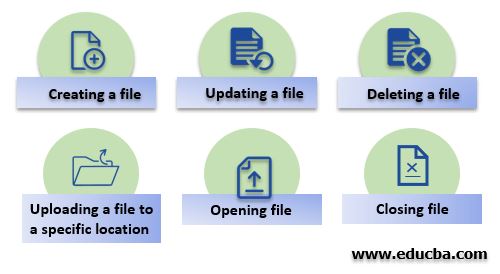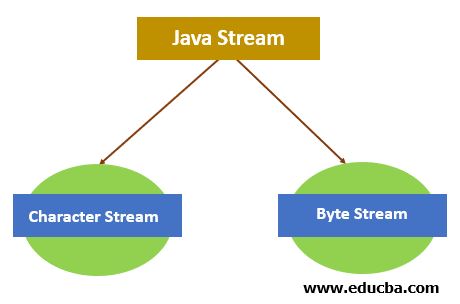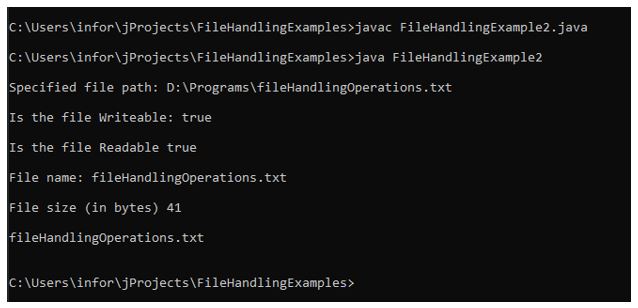Java 中的文件处理
- WBOY原创
- 2024-08-30 15:36:53999浏览
文件处理是指在java中处理文件。读取文件和写入 java 文件称为 java 中的文件处理。 FILE 是一个可以包含不同类型信息的容器。文件可以包含文本、图像、视频、表格等
广告 该类别中的热门课程 JAVA 掌握 - 专业化 | 78 课程系列 | 15 次模拟测试开始您的免费软件开发课程
网络开发、编程语言、软件测试及其他
在 java 中,File 类使我们能够处理不同类型的文件。 File 类是 java.io 包的成员。 Java提供了各种读取、写入、更新和删除文件的方法。
操作类型
可以对文件执行的不同类型的操作如下:

- 创建文件
- 更新文件
- 删除文件
- 上传文件到特定位置
- 打开文件
- 关闭文件
语法:
要在程序中使用文件,您需要导入 java.io 包。导入此包将为您提供一个 File 类,您可以通过在 File 类的构造函数中引用该文件来初始化该类。
//importing file class
import java.io.File;
//File name passed to the object
File fileObj = new File("file.txt");
文件处理如何工作?
在 Java 中,文件处理是通过流概念进行的。文件的输入/输出操作通过流执行。流是指数据的序列。
在java中,Stream有两种类型:

- 字符流:字符流是指涉及字符的流。 数据处理是通过文件中的字符流进行的。
- 字节流:我们将以字节为单位传输数据的流称为字节流。数据处理通过文件中的字节流进行。
文件处理方法
下面给出了一些在 java 中执行不同操作的方法:
- createNewFile():createNewFile 方法用于创建一个空文件。它以布尔值形式返回响应。
- getName(): 该方法用于获取文件名。它返回字符串,即响应中的文件名。
- getAbsolutePath(): 它返回文件的绝对路径。该方法的返回类型是字符串。
- canRead(): 此方法检查文件是否可读。 它返回一个布尔值。
- canWrite(): 此方法检查文件是否可写。它返回一个布尔值。
- delete(): 此方法用于删除文件。它返回一个布尔值。
- exists(): 使用此方法检查文件是否存在。 它返回一个布尔值。
- length(): 此方法返回文件大小(以字节为单位)。该方法的返回类型为long。
- list(): 此方法返回目录中可用文件的数组。它返回一个字符串值数组。
- mkdir(): 要创建新目录,请使用此方法。它返回一个布尔值。
Java 文件处理示例
以下是 Java 中文件处理的示例:
示例#1
在此示例中,程序使用各种方法来获取特定详细信息。在这个应用程序中,使用不同的方法来获取与文件相关的信息,例如:
- 检索文件的绝对路径。
- 检查文件是否可写。
- 检查文件是否可读。
- 正在检索文件名。
- 正在检索文件大小。
- 获取指定目录中存在的文件列表等
代码:
导入io包不同的类。
import java.io.File;
import java.io.IOException;
public class FileHandlingExample2 {
public static void main(String[] args) {
// Creating an object of a file
File fileObj = new File("D:/Programs/fileHandlingOperations.txt");
if (fileObj.exists()) {
//retrieving the path of the specified file
System.out.println("\nSpecified file path: " + fileObj.getAbsolutePath());
//checking whether the file is writable or not
System.out.println("\nIs the file Writable: " + fileObj.canWrite());
//checking whether the file is Readable or not
System.out.println("\nIs the file Readable " + fileObj.canRead());
//retrieving file name
System.out.println("\nFile name: " + fileObj.getName());
//retrieving file size
System.out.println("\nFile size (in bytes) " + fileObj.length());
File fileDirObj = new File("D:/Programs/");
String[] fileList = fileDirObj.list();
//displaying here the list of files available in the directory
for (int i = 0; i < fileList.length; i++) {
System.out.print("\n" + fileList[i]);
}
System.out.println("\n");
}
else {
System.out.println("Specified file does not exist.");
}
}
}
输出:
在上面给出的示例中,我们可以看到不同的方法如何提供执行与文件相关的不同检查所需的信息。

示例#2
这个例子展示了程序中如何使用不同的方法来执行不同类型的操作。程序中使用exists()方法检查文件是否存在;之后,放置 if..else.. 条件。
In the If condition, it checks first whether the existing file is writable or not; if the existing file remains writable, then the code block under the if section uses the FileWriter class method to write content into the existing file.
Code:
Importing io package different classes.
import java.io.File;
import java.io.FileWriter;
import java.io.IOException;
public class FileHandlingExample {
public static void main(String[] args) {
try {
File fileObj = new File("D:/Programs/fileHandlingOperations.txt");
if(fileObj.exists()){
System.out.println("File already exists.");
if(fileObj.canWrite()){
//creating object of FileWriter class to write things on file
FileWriter fwObj = new FileWriter("D:/Programs/fileHandlingOperations.txt");
// Writes this content into the specified file
fwObj.write("It is a basic example of writing in file!");
//closing the files once writing completed
fwObj.close();
System.out.println("\nContent has been written to the file.");
}else{
System.out.println("\nFile is not in writable mode.");
}
;
}else{
if (fileObj.createNewFile()) {
System.out.println("New File created: " + fileObj.getName());
}
}
}
catch (IOException ioError) {
System.out.println("An error occurred.");
ioError.printStackTrace();
}
}
}
Output:
In the above-given example, After compilation, running the program the first time will create a file with the specified name in the program.

Running the program a second time will write the content in the existing file.

Conclusion
The article above explains what a file is, how to perform operations on it, and how file handling works. It was also demonstrated in the above section about classes & methods that can be used to work with files in java.
以上是Java 中的文件处理的详细内容。更多信息请关注PHP中文网其他相关文章!

